History of the Fruit
It was only recently that the yuko was rediscovered and recognized as an astringent citrus fruit native to Japan. In appearance the fruit resembles the yuzu ( Citrus junos ) and kabosu ( C. sphaerocarpa ). When it ripens, the outer rind and flesh turn a bright yellow that calls to mind the lemon. The yuko has many seeds, a sharp but well-rounded flavor, and juicy flesh; the white inner rind is also edible, like that of the hyuganatsu ( C. tamurana ), another Japanese member of the citrus genus. The rind of the ripened fruit has a sweet scent similar to other fruits like the pomelo and yuzu .
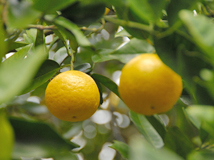
The history of this fruit is far from clear. One theory holds that the yuko came about from natural crossbreeding between other species like yuzu and pomelo. The yuko grows naturally from seed, is polyembryonic, or capable of producing multiple seedlings from a single seed, and carries out monogonous, or asexual, reproduction. There are a number of yuko trees standing today that have stood for more than a century, and it is believed that this species was in distinct existence by the middle of the nineteenth century.
Today yuko trees grow in areas of the city of Nagasaki like the Doinokubi and Sotome districts. These were part of the same Saga domain during the Edo period (1603-1868), but some 20 kilometers separate them, and it is thought that the yuko developed independently in both of the districts.
Yuko trees grow alongside pomelo and summer orange trees in residential yards and farm fields of the Doinokubi district, where, as in Sotome, people have harvested and consumed their fruit. The trees can also be found alongside area roads, though, suggesting that birds may have scattered the seeds to sprout in various locations. Nagasaki has traditionally been home to a large Christian population, including the clandestine Christians of the Edo period, when the religion was banned, and the area has deep ties to the faith. Some believe that the French missionary Marc Marie de Rotz (1840-1914) sought to spread cultivation of the yuko as a means of improving the living standards of the area's impoverished villagers.
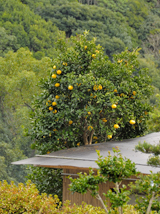
In both Doinokubi and Sotome, yuko is used to add flavor to vinegared side dishes and to garnish fish including sardines. Children eat the fruit and drink its juice. The fruit has traditionally been floated in bathtubs for a fragrant bathing experience and used medicinally to treat the common cold and other ailments. Since the strains in use have come from naturally growing trees, rather than managed, cultivated ones, the fruit shows great diversity in the thickness of its rind, its size, and its flavor. For the people in these communities, leading subsistence lifestyles and depending on both farming and fishing for their livelihoods, this lack of uniformity may have even made the fruit more attractive to them, as they could choose from among the various yuko types according to their intended use.
Beginning in the 1960s, the yuko began disappearing rapidly from the Nagasaki region. There were various reasons for this. First of all, farmers introducing satsuma oranges feared crosspollination would reduce the value of their new crops. Second, mass production of vinegar and other seasonings reduced the need for homegrown citrus fruit. Third, the trees got in the way of farmers' efforts to expand fields for vegetable production. And fourth, the yuko trees grew tall relatively quickly, making it difficult to harvest their fruit. In Doinokubi in particular, urbanization and the expansion of residential neighborhoods accelerated the decline of the species.
In a few short decades the yuko had declined almost to the point of extinction. In 2001 Masanori Kawakami, then the chief of Nagasaki City Hall's branch office in Doinokubi and the head of the local public community center, learned of this threatened fruit and carried out a survey of the remaining trees together with researchers from the Nagasaki Fruit Tree Experiment Station and other organizations. This was the beginning of a movement to protect and revitalize the yuko populations, mainly of the Doinokubi and Sotome districts.
Resuscitation of a Species
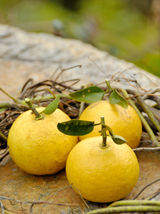
Kawakami's rediscovery of the yuko took place in 2001, when he went into the Nagasaki hills to survey the old "lord's road," used by the ruler of the Fukahori fiefdom to travel back and forth to the Saga domain, whose lord he served as a principal retainer. Tatsunori Konaka, then head of the Doinokubi community association, picked a fruit from a roadside tree and handed it to Kawakami, who then took his first bite of yuko . He found the fruit to have a flavor all its own, although similar to that of a summer orange. Wanting to know more about the yuko -its formal name, the common name's etymology, and the fruit's characteristics-he sent a photograph to the producers of a televised gardening program. A response came from Hirohisa Nesumi of the National Institute of Fruit Tree Science. In the correspondence that followed Kawakami sent samples of the fruit, branches, and leaves to the institute, which determined that this could be a previously unknown species and proposed a survey of the distribution, height, spread, and girth of the trees. This marked the beginning of a community effort led by Konaka to catalog the tree population. Ken'ichi Kose, who was then a supervisor in the Nagasaki City Department of Agriculture and Forestry, cooperated in the survey efforts as part of a city project to promote local production and consumption of agricultural products. Nesumi and other researchers began taking a serious scientific look at the outer appearance of the yuko and the makeup of its rind, flesh, and seeds, eventually determining it to be a new species based on its morphology and chemical composition.
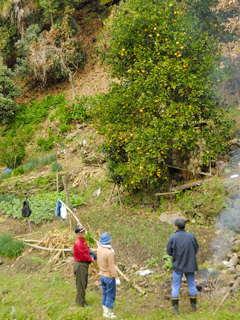
It was after this that word came to Kawakami of yuko trees growing in the Sotome district. He went there and worked together with Sugino Hiu, leader of a local farming revitalization group, to survey the Sotome trees, discovering them to be even greater in number than the Doinokubi trees. Over time Kawakami came to be known as a knowledgeable advisor on the yuko for his involvement in the rediscovery of the fruit in these two districts. Kose, meanwhile, went on to volunteer his efforts as a local resident involved in tree-planting festivals in both Sotome and Doinokubi and in providing guidance on how best to raise the trees.
In recent years seed tree farms have been established in both districts, and residents are now raising more than 100 yuko seedlings. Nobuteru Nakao, a citrus farmer and farm management consultant certified by Nagasaki Prefecture, has since 2007 been at the center of efforts including citrus farmers and the Nagasaki city government's department promoting local food production and consumption to set up a system for increasing yuko production and making the fruit part of the region's branding efforts. Eight designated farmers in the city of Nagasaki are now growing yuko in this system.
State of the Yuko Today
As of December 2007, there were a confirmed total of 116 yuko trees standing in the two producing districts, with 52 in Doinokubi and 64 in Sotome. It is hard to get accurate numbers for fruit yield per tree, but hearings carried out in the two districts indicate that each tree produces upwards of 500 yuko per season on average. Residents in both areas begin harvesting the fruit around September, when the skin is still green, for use in place of vinegar. In November the fruit takes on its yellow color and is harvested and eaten fresh. Some yuko can score as high as 12 degrees on the Brix scale of sugar content, making them some of the sweetest astringent citrus fruit anywhere. The species is characterized by a particularly long harvest season, lasting from September through March. No pesticide is applied to the trees, so people can take bites through the rind and use the entire fruit, rind and all, without concern. Compared to the yuzu and Seville orange, which can overpower dishes, the yuko is a better choice for cooking thanks to its milder aroma that accents and brings out the taste of the food it flavors. The yuko is also a welcome addition to the kitchen as a fruit that can be used in its entirety, leaving nothing to throw away.
The people now working to bring this species back to vitality note that since yuko trees sprouted here and there naturally, people harvested the fruit for personal consumption as a matter of course, without giving thought to the importance of the species. It was the danger that the species might disappear that sparked their recognition of the role the yuko played in the food culture, daily life, and history of the area, and their awareness that the species was a vital one to keep around.
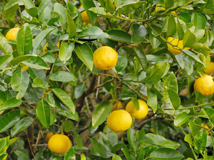
In Japan today there are numerous examples of foods that are important to the lives and food culture of a region's residents but are cultivated only for their own consumption. When the focus shifts to a crop's production capacity and economic benefits, these foods tend to fall into decline, even to the point of disappearing completely. The astringent citrus varieties that people have traditionally grown in their own yards and used in cooking seem particularly susceptible to this trend. The tale of the yuko and its resurgence in recent years is a highly instructive one in the consideration of the importance of these noncommercial foodstuffs and fresh approaches to their place in our lives in the modern era.
Kurokawa, Yoko
Research Adviser
Culinary scholar. Her research focuses on the crafts and techniques used in cooking, agriculture, forestry, and fishing. While involved in the slow food movement, she met with farmers in her native Nagasaki who grew a wide variety of crops without pesticides and realized the importance of protecting the local characteristics and diversity of food. She is involved in a range of activities that benefit society by building closer connections between food producers and consumers.
Photos: Kazuo Kikuchi
